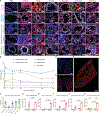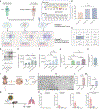In vivo editing of lung stem cells for durable gene correction in mice
- PMID: 38870301
- PMCID: PMC12208706
- DOI: 10.1126/science.adk9428
In vivo editing of lung stem cells for durable gene correction in mice
Abstract
In vivo genome correction holds promise for generating durable disease cures; yet, effective stem cell editing remains challenging. In this work, we demonstrate that optimized lung-targeting lipid nanoparticles (LNPs) enable high levels of genome editing in stem cells, yielding durable responses. Intravenously administered gene-editing LNPs in activatable tdTomato mice achieved >70% lung stem cell editing, sustaining tdTomato expression in >80% of lung epithelial cells for 660 days. Addressing cystic fibrosis (CF), NG-ABE8e messenger RNA (mRNA)-sgR553X LNPs mediated >95% cystic fibrosis transmembrane conductance regulator (CFTR) DNA correction, restored CFTR function in primary patient-derived bronchial epithelial cells equivalent to Trikafta for F508del, corrected intestinal organoids and corrected R553X nonsense mutations in 50% of lung stem cells in CF mice. These findings introduce LNP-enabled tissue stem cell editing for disease-modifying genome correction.
Figures



Comment in
-
Gene editing flows to the lungs.Science. 2024 Jun 14;384(6701):1175-1176. doi: 10.1126/science.adq0059. Epub 2024 Jun 13. Science. 2024. PMID: 38870313
-
A rush of CRISPR to the lungs.Nat Rev Drug Discov. 2024 Aug;23(8):580. doi: 10.1038/d41573-024-00117-0. Nat Rev Drug Discov. 2024. PMID: 38987628 No abstract available.
References
-
- Wang JY, Doudna JA, Science 379, eadd8643 (2023). - PubMed
-
- Hajj KA, Whitehead KA, Nat. Rev. Mater 2, 17056 (2017).
Publication types
MeSH terms
Substances
Grants and funding
LinkOut - more resources
Full Text Sources
Medical
Molecular Biology Databases

